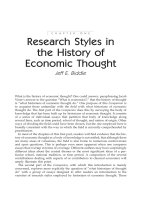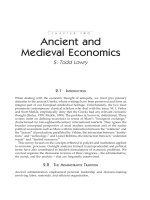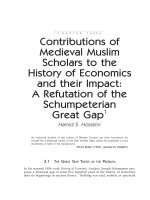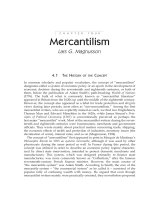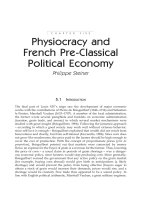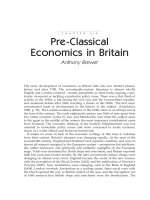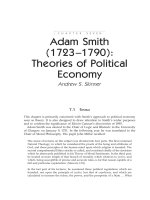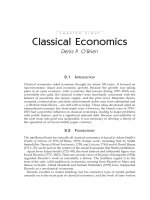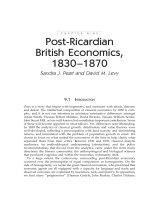A Companion to the History of Economic Thought - Chapter 8 ppsx
Bạn đang xem bản rút gọn của tài liệu. Xem và tải ngay bản đầy đủ của tài liệu tại đây (225.51 KB, 18 trang )
112 D. P. O’BRIEN
CHAPTER EIGHT
Classical Economics
Denis P. O’Brien
8.1 INTRODUCTION
Classical economics ruled economic thought for about 100 years. It focused on
macroeconomic issues and economic growth. Because the growth was taking
place in an open economy, with a currency that (except during 1797–1819) was
convertible into gold, the classical writers were necessarily concerned with the
balance of payments, the money supply, and the price level. Monetary theory
occupied a central place, and their achievements in this area were substantial and
– with their trade theory – are still with us today. Those ideas developed amid an
international economy free from major wars. However, the French wars of 1793–
1815 had a powerful influence on classical economics, leading to major problems
with public finance, and to a significant national debt. Because convertibility of
the note issue into gold was suspended, it was necessary to develop a theory of
the operation of an inconvertible paper currency.
8.2 FOUNDATIONS
The intellectual basis for virtually all classical economics is found in Adam Smith’s
Wealth of Nations of 1776 (O’Brien, 1975). Earlier work, including that by Smith
himself (his Theory of Moral Sentiments, 1759, and Lectures, 1763) and of David Hume
(1711–76) can be seen in the context of the research program that Smith established.
Apart from Adam Smith (1723–90), the most famous and influential figure was
David Ricardo (1772–1823). There are several views of Ricardo. Schumpeter (1954)
regarded Ricardo’s work as essentially a detour. The Sraffians regard it as the
start of the only valid tradition in economics, running from Ricardo to Marx and
thence to Sraffa. Alfred Marshall and Samuel Hollander (1979) have interpreted
Ricardo as a neoclassical economist.
Ricardo excelled in model building, but his restrictive type of model grafted
uneasily on to the main part of classical economics, and the work of later writers
CLASSICAL ECONOMICS 113
such as J. R. McCulloch (1789–1864) and J. S. Mill (1806–73) owed much more to
Smith than to Ricardo.
To interpret classical economics in terms of Smith and Ricardo alone is a
mistake (O’Brien, 1988). Contemporary with Ricardo were T. R. Malthus
(1766–1834), James Mill (1773–1836), Nassau Senior (1770–1864), Robert Torrens
(1780–1864), and numerous writers on special topics, especially monetary
theory.
Most classical economists had intellectual interests besides economics. Few had
academic employment. Journalism, the law, and business – especially banking
– were mostly their occupations. Yet these writers formed a “scientific com-
munity.” With the exception of the French economist J B. Say (1776–1832),
they lived in the British Isles. They read the literary reviews of the day, and there
was an active circulation of pamphlets. They met at the Political Economy Club
and in other societies such as the [Royal] Statistical Society.
Economics grew out of philosophy. Smith and Hume were the products of a
distinctive Scottish philosophical school. The influence of Smith’s teacher, Francis
Hutcheson, is discussed in Skinner’s contribution to this Companion. In addition,
the utilitarian strain in the classical literature, usually associated with Jeremy
Bentham (1748–1832), has its origins in this Scottish philosophical tradition,
leading to Smith’s stress on the welfare of the laboring classes.
Absorbed into this philosophical background were ideas from more narrowly
economic literature that developed during the century before Smith’s great work.
The most important example is the work of the physiocrats and A. R. J. Turgot
(1727–1781) in France (Turgot, 1769), whose ideas and influence on Smith are
described elsewhere in this volume. In some respects, what was borrowed from
France merely reinforced ideas that Smith had developed earlier, as is clear from
notes on lectures that Smith delivered in 1763.
Smith’s debt to some of his English predecessors is not always so clear,
although it is hard to ignore the likely influence of Bernard Mandeville’s (1660–
1733) Fable of the Bees (1714). Smith’s emphasis on individual self-interest as
productive of social benefit reflects that of Mandeville. Smith avoids mentioning
Mandeville and Sir William Petty (1623–87), who undoubtedly influenced Smith’s
views on public finance, if only on the treatment of equality in taxation.
The wide-ranging basic concepts of the Wealth of Nations set the agenda for the
whole classical era. The individual pursues self-interest that, constrained by a
framework of law, religion, and custom, and an inherent moral sense (sympathy),
brings about a coincidence of private and public satisfaction. Competition in
response to price signals allocates resources as capital pursues profit opportunities,
and the search for greater output from the resources commanded by capital leads
to specialization and division of labor, the mainspring of technical progress.
Freedom of trade stimulates technical progress and widens the market, allowing
disposal of the increased output – division of labor depends on the extent of the
market.
Ricardo, reading Smith with the mind of a model builder (Ricardo, 1815, 1817–
21), was to have a huge, if ultimately transient, influence on the way in which
that agenda was developed. For Ricardo was concerned with two immediate
114 D. P. O’BRIEN
practical problems, inflation and agricultural protection; and he found that the
material in the Wealth of Nations failed to provide clear-cut answers.
In the Bullion Controversy, the price level in relation to the balance of pay-
ments was critical. Smith had argued that a rise in wages would ultimately raise
the price level. But Ricardo concluded that, in an open economy on the gold
standard, the price level could not rise permanently; after an initial increase,
a balance-of-payments deficit would ensue, gold would flow out, the money sup-
ply would be reduced, and prices would return to the initial level. This insight,
it has been plausibly argued (Hollander, 1979; cf., Peach, 1988), led Ricardo to
argue that profits would be compressed by a rise in wages.
Applying the argument to agricultural protection, one could predict dire
consequences for growth. Protection increased agricultural costs as inferior land
was brought into use to feed a growing population; this meant a rising price of
corn. For the laborer to purchase the same amount of corn, money wages would
have to rise. Profits would fall and accumulation of capital would slow and
ultimately stop. The economy would reach a stationary state.
The landlords’ share of total output, rent, would increase as diminishing re-
turns ensured a growing gap between total product and the net product shared
between profit and wages. With wages at subsistence, profits would fall to a
minimum. The landlords’ interests conflicted with the rest of society – to the
extent, as Ricardo argued (wrongly, because he neglected the economic interests
of individual landlords) that improvements in agricultural technology were against
their interests.
Ricardo’s model had a considerable impact on economic thought over perhaps
two decades. But there was misunderstanding. Ricardo was believed to have
developed theorems consistent with Smith’s basic program, in some instances
correcting Smith’s conclusions. But it eventually became apparent that Ricardo
had constructed an analytic framework that was qualitatively different from
Smith’s, and classical economics developed along a path increasingly divergent
from that laid down by Ricardo.
Malthus’s work also enjoyed this ambiguous position in relation to the body of
classical literature. Malthus’s core ideas go back at least to Cantillon, writing in
about 1730. But Malthus provided the version of the population theory underlying
classical economics, articulating a conflict between a geometric rate of increase
of population and an arithmetic increase in food supply. This had the analytic
advantage, especially for Ricardo, of leading to the conclusion that population
would increase to the point at which wages were at subsistence, allowing the
wage level to be treated as a constant.
The second edition of his Essay on Population (1803) removed this certainty.
Malthus introduced the idea that population might, or might not (if moral
restraint, as distinct from vice, limited procreation), press up against the limits
of the food supply. In this form the population theory was incorporated into
nineteenth-century economics. According to Senior, population might be limited
not by actual shortage, but by anticipation of it. J. S. Mill allowed Malthus an
honored place in his Principles (1848) while denying that Malthus had attached
any importance to his arithmetical and geometric ratios, restating the tautological
CLASSICAL ECONOMICS 115
“tendency” as an economic law that could be modified only by the spread of
methods of family limitation.
To understand how all these threads fit together, it is best to look at the classical
treatment of particular aspects of economic analysis.
8.3 VALUE AND DISTRIBUTION
8.3.1 Value
Smith designed his value theory to produce a theory of relative price, on the
basis of adding up the per-unit costs of the labor, capital, and land inputs into
production, the valuation of the inputs being determined separately. He explained
the value of commodities in long-run equilibrium, in terms of wages, profit, and
rent. Market price fluctuated around long-run equilibrium price, with departures
from long-run equilibrium eliminated by the mobility of capital in response to
profit opportunities or losses.
Ricardo attempted to replace Smith’s adding-up approach with a labor theory
of value, creating problems for his contemporaries and successors. Even if capital
amortization were treated as payments to stored-up labor, relative values could
change without any change in labor input, if the capital–labor ratios were not
uniform across all commodities. This would happen when wages rose and profits
fell. Ricardo claimed that this would only produce variations of 6 or 7 percent in
value. But the problems were tied up with the basic Ricardian model: for money
wages were supposed to rise with the growth of population and the rising cost of
obtaining food, thus altering values. Ricardo further posited an average capital–
labor ratio, and the existence of a commodity produced under such conditions –
the “Invariable Measure.” He then decided that gold would fit that specification,
and treated agriculture as operating with the same capital–labor ratio. Thus a
rise in wages would not, of its own, alter the money price of corn. If the money
price of food did rise, this must signal the existence of diminishing returns in
agriculture.
In analyzing rent, Ricardo introduced one of the longest-lasting fallacies in the
history of economics. Rent, he argued, was an intramarginal surplus, due to the
existence of diminishing returns in agriculture. Economists now conventionally
envisage this as a rising agricultural supply schedule, with an area of producer
surplus lying between the supply schedule and the market price. Because rent
was a surplus, Ricardo argued that it did not determine price but was determined
by price. The argument neglected transfer earnings: to grow one crop, land had to
be paid sufficient to prevent it being used for another crop. The cost of the land
did enter into the cost of production when where there were many agricultural
products, rather than the single product “corn” of Ricardo’s model.
All this has to be seen in the context of Ricardo’s overriding aim – to produce
a model of growth and stagnation. This was not understood by his contemporar-
ies, who were concerned with relative price and saw no role for “Absolute Value”
in terms of the “Invariable Measure.” McCulloch clearly envisioned an improved
116 D. P. O’BRIEN
cost of production theory: accepting the elimination of rent from cost, he
wrestled vainly with the problem of capital and the nature of profit. Torrens
adopted a different approach and argued that relative amounts of capital, rather
than labor, determined relative price. However, since the valuation of the capital
turned out to depend upon the number of days of labor “stored up,” this was no
advance.
J. S. Mill’s treatment of the cost of production approach to value provides
insight into Ricardo’s influence. First, Mill rejected Ricardo’s “Invariable Meas-
ure” and insisted that value was only a relative term. Secondly, Mill emphasized
the fluctuation of market price around the long-run natural (cost of production)
price; but cost could vary with output, and some products could command a
scarcity value. Cost of production comprised wages and profits (depreciation
was seen as wages and profits incurred in the past); rent was not an element of
cost of production. Things could only differ in relative value if they required
more labor, or labor paid at higher wages, differed with respect to the capital–
labor ratio, or were the products of industries that required a higher rate of
profit. Ricardo’s influence is apparent both in the “getting rid of rent” and the
recognition that varying capital–labor ratios would produce changes in relative
values if average wages rose and profits fell: but his contributions only modified
a basically Smithian cost of production approach.
The French tradition of J B. Say had a wholly different approach, one consist-
ent with the post-1870 approach to value theory: of the interaction of subjective
valuation (underlying demand) and limitations in supply. Say argued that both
goods and productive services derived their value from the utility of the final
product. Price was determined by the intersection of a negatively sloped demand
curve (described verbally) and a rising supply schedule.
Say (1817) explained the declining demand schedule in terms of income dis-
tribution, not utility. Two later writers developed the argument further. Nassau
Senior explained the idea of diminishing marginal utility, although he did not
relate it to a demand curve (Senior, 1836), while the Irish economist Mountifort
Longfield put forward a strikingly modern subjective value theory (Longfield,
1834). Value depends upon demand and supply: cost of production limits supply,
and demand depends upon diminishing marginal utility. Marginal utility varies
between units of a commodity and between persons. Rather than relying upon
income distribution to derive a negatively sloped demand schedule, Longfield
derived it explicitly from diminishing marginal utility. Longfield was followed by
others in this tradition (Black, 1945).
8.3.2 Distribution
To avoid explaining prices by prices, the cost-of-production theorists had to
provide a theory of the valuation of factor services.
WAGES
The main development followed two lines. One involved the concept of subsistence
wages. Commentators disagree about the extent to which the subsistence was
CLASSICAL ECONOMICS 117
physical, although if it were merely conventional (psychological) subsistence,
including some luxuries, it is difficult to see why a fall in wages below that level
should reduce population, unless perhaps through postponement of marriage.
The concept of subsistence provided a theory of the long-run equilibrium wage.
But the classical literature focused mainly on the market period, and the so-called
wage fund. In the market period, the supply of labor could be taken as fixed; the
wage rate was then determined by the intersection of a vertical market supply of
labor and a demand curve for labor of unit elasticity, its position being depend-
ent on the size of funds pre-accumulated to employ labor. Thus capital, not
demand for commodities, constituted demand for labor.
This approach left open many questions, including the determination of the
size of the labor force given the population, the determination of the size of the
wage fund itself (particularly as, in the classical analysis, a tax on wage goods
was generally to be passed on, implying that it increased the size of the wage
fund), and the division of a given stock of capital between fixed and variable
capital.
PROFIT
Profit, as distinct from wages of management, was the return on capital, identi-
fied as interest plus a risk premium. The source of the interest element in profit
still needed analysis. Some writers recognized that capital increased total output,
thus sensing that its reward must be linked in some way to productivity. But
Samuel Bailey (1791–1870) and, more importantly, Nassau Senior developed the
idea of time-preference, which limited the supply of this productivity-enhancing
(and thus demanded) factor (Bailey, 1825; Senior, 1836). The combination of lim-
ited supply and positive demand gave rise to a positive price for the services of
capital.
J. S. Mill’s more elaborate treatment analyzed the motives for saving, con-
sidered the power to save out of income, and equated the rate of interest with
the marginal supply price of saving. Longfield had argued that demand for capital
at the margin could be identified with the marginal product of capital; Mill
independently advanced the same argument.
The level of profit was thus dependent on both the demand for investment
(in relation to the available supply of investment funds) and the demand for
consumption goods (which influenced the productivity of that investment), as
the classicists from Smith onward recognized. Ricardo argued differently, that
the rate of profit for the economy as a whole was determined by the marginal
rate of profit in the agricultural sector. This was consistent with showing how
diminishing returns in agriculture would bring the economy to a stationary state.
His contemporaries felt that increasing manufacturing productivity would offset
diminishing returns in agriculture. Ricardo’s view was arrived at by dividing the
whole economy into one giant farm and a series of manufacturing tributaries.
Then the profit-raising effect of innovation in any tributary would be swamped
by both capital inflow and the effect of rising wages (due to agricultural dimin-
ishing returns), both of which raised costs and lowered the relative value of
(capital-intensive) manufactures.
118 D. P. O’BRIEN
RENT
The Ricardian theory of rent as intramarginal surplus was due at least equally to
Sir Edward West, Malthus, and Torrens; all four men published in 1815.
Given the classical treatment of rent, wages, and profits, the treatment of rel-
ative shares was easily discernable. Wages would eventually reach subsistence
(although perhaps not physical subsistence); but wage-earners would enjoy spells
during which wages were greater than subsistence as capital accumulation ran
ahead of population increase. Profits would fall to a minimum, as a result of both
capital accumulation in relation to investment opportunities (Smith, Malthus,
and J. S. Mill) and diminishing returns in agriculture (Ricardo). Rent would rise
both as a share of national income and in absolute amount.
8.4 MONEY
8.4.1 Background
Classical monetary theory focused on gold and silver money and bank notes,
treating bank deposits as devices for increasing the velocity of circulation,
even though the concept of the deposit multiplier was put forward in the
1820s by James Pennington (1777–1862) (Pennington, 1826–40) and Robert Torrens
(1837).
The theory, stemming from Hume (1752), became known as the price specie-
flow mechanism: A country’s price level is a function of its money supply; the
equilibrium price level depends upon its balance-of-payments equilibrium. If
the price level is too high, an outflow of metal will reduce the money supply (and
the price level) to equilibrium, and vice versa. Worldwide, the value of gold
and silver depend on their cost of production. But the relative value of gold and
silver on the one hand, and of commodities on the other, within a country, is
defined by balance-of-payments equilibrium. This mechanism proved to be the
pivotal idea in the two great monetary controversies of classical economics.
8.4.2 The Bullion Controversy
In 1797 the Bank of England suspended convertibility of its notes into gold,
leading to the first major controversy between those who believed that causality
ran from the money supply to the price level and those who believed the money
supply responded passively to the price level. Those in the first camp, the
Bullionists, blamed the Bank of England for generating inflation by over-issuing
notes. Following Hume, for the Bullionists causality ran from the money supply
to the price level. But their policy prescriptions differed. Some held to this
position rigidly, and their position has come to be called the Ricardian Definition
of Excess: whenever there are two symptoms of excess (paper) money supply –
a high value of gold bullion (a low value of bank notes) and a depreciated
exchange rate – then, by definition, the currency supply (Bank of England notes) is
excessive, and the Bank should contract its issues.
CLASSICAL ECONOMICS 119
The other group of Bullionists, led by Henry Thornton (1760–1815), argued
that while these tests were valid if the symptoms were sustained, they could, in
the short run, arise from other causes (Thornton, 1939 [1802]), such as harvest
failure or financial panic. Severe damage to the economy could be caused by
contracting the note issue in response to transient causes of pressure.
Nevertheless, both groups agreed that in the long run the Bank must restrict its
note issue sufficiently to permit a return to convertibility of its notes into gold.
The Anti-Bullionists, by contrast, argued that the Bank’s note issue was simply
responding to “the needs of trade” as indicated by the “real bills” presented to it
for discount. The “real bills” were bills of exchange resulting from real transac-
tions in goods and services.
Their position was not sustainable. First, many of the notes issued had nothing
whatever to do with “real” transactions, but were ultimately a consequence
of the Bank’s position both as the government’s bank and as lender of last resort
to the financial sector, a position recognized since statements of it by Francis
Baring (1797) and Thornton. Secondly, as Thornton pointed out, even had the
Bank confined itself to “real bills,” the transactions to which they related had to
take place at some absolute price level – and in the Bullionist analysis the price
level depended on the money supply. Thirdly, Anti-Bullionists argued that the
Bank could not over-issue its notes because it charged interest (discount) when
issuing notes, so no one would demand notes for which they had no need. But,
as Thornton indicated, there was an indefinitely large demand for loans and
discounts if the rate that the Bank charged was less than the marginal rate of
profit.
Ultimately the Bullionist case triumphed. Convertiblity was progressively
restored from 1819. However, the 1820s and 1830s witnessed a series of financial
crises and brought convertibility into question, as the Bank of England became
hard pressed for gold. The debate on the terms on which the Bank’s charter
would be renewed in 1844 formed the basis of the next controversy.
8.4.3 The Currency and Banking Debate
Issues from the Bullion Controversy reappeared in the Currency and Banking
Debate. The Currency school, positing an endogenous cycle of real income
(O’Brien, 1995), argued that if the money supply (Bank of England notes) were
regulated in accordance with the Ricardian definition of excess – contracted
whenever there was a balance-of-payments deficit – this could act countercyclically.
A balance-of-payments deficit was due to a rising price (and income) level,
indicating the need for monetary contraction. The Banking school’s prescription
of allowing the money supply to respond to the “needs of trade” would magnify
the cycle and, by intensifying the price-level rise that had produced the balance-
of-payments deficit, result in a gold outflow endangering the convertibility of the
note issue into gold.
The Banking school maintained that the money supply depended on the price
level, that the balance of payments did not depend upon the price level, and
that deficits were self-reversing. Over-issue of notes was impossible if the Bank
120 D. P. O’BRIEN
adhered to discounting only “real bills” – any over-issue would automatically
return to the Bank under the so-called Doctrine of Reflux.
Both disputants shared certain assumptions, including acceptance of the need
for convertibility and of the key role of the Bank of England note issue in the
money supply. Neither assumption went completely unquestioned. Thomas Joplin
(ca. 1790–1847) argued that the country bank notes were not, as both the Bullionists
and the Currency school believed, controlled by the high-powered money base of
the Bank of England notes; even more damagingly, he argued that the predomin-
ant influence on the price level was these country bank notes rather than those
issued by the Bank (O’Brien, 1993).
Joplin accepted that the link with gold should be maintained under normal
circumstances. Members of the Birmingham school, notably Thomas Attwood
(1783–1856), did not even go this far (Attwood, 1816–43). They urged an incon-
vertible paper currency to inflate aggregate demand, with the aim of reducing
unemployment. This idea had respectable antecedents: Hume and Malthus had
argued that increases in the money supply would increase output and employ-
ment. But inflation as a policy had few supporters – the experience of the Assignats
in Revolutionary France had demonstrated the danger of hyperinflation.
Aggregate demand was not ignored by the classical writers. Say’s Law
provided an explanation of the underlying circularity of the economic system.
But the classical writers, especially J. S. Mill in his Unsettled Questions (1844), re-
cognized that outside a barter system there could be excess demand for money,
and that market clearing in a monetary, as distinct from a hypothetical barter,
economy was an equilibrium proposition. Monetary changes were not neutral –
if the classical economists had believed they were, the Bullion and Currency and
Banking Controversies would have been pointless.
8.5 TRADE
8.5.1 Smith and the gains from trade
Perhaps the most prominent feature of classical economics is the central import-
ance attached to trade, and the corollary that trade should be free of restrictions.
The intellectual underpinnings of this position are complex.
Adam Smith set the tone by offering a critique of existing restrictionist trade
policy, sustained and defended as it was by interest groups. The basic grounds
for Smith’s position, however, involved a blurring of the distinction between
home and foreign trade. Specialization and division of labor increased output per
head, but were limited by the extent of the market. Freedom of trade increased
the extent of that market, allowing greater division of labor. International trade,
like interregional trade, was thus based upon the source of supply being the
producer with absolute advantage. An international outlet for the increased
output was offered by trade – this was later called the Vent-for-Surplus doctrine
– in exchange for goods (and raw materials) produced more efficiently abroad.
But for sources of supply to be absolutely the most efficient, it was necessary for
CLASSICAL ECONOMICS 121
factors to migrate to where they could work most efficiently, which labor could
not. J. S. Mill explained that for trade to be based upon absolute advantage, labor
would have to migrate in search of its highest productivity, as its output would
have to be sold in the same market wherever it worked, but the return to capital
would be higher, the lower the resource input.
8.5.2 Comparative advantage
If resources were not fully mobile internationally, it was still possible for trade
to yield advantages for all parties, even though some of them were not the most
efficient in terms of resource use. This idea, developed as the principle of
comparative advantage, is usually associated with Ricardo’s Principles of 1817.
However, Robert Torrens published the idea two years before Ricardo (Torrens,
1815; Robbins, 1958). The argument was basically that if one country were gener-
ally more efficient than another, it would initially run a balance-of-payments
surplus and gold would flow to it. This would inflate its money supply and raise
its price level, with this process continuing until both countries were in balance-
of-payments equilibrium. The more efficient country would import those com-
modities in which its productivity advantage was least, and export those in which
its superiority was greatest.
8.5.3 The terms of trade
Division of the gains from trade between countries depended on the terms
of trade, but Ricardo left unexplained the forces determining them. J. S. Mill
explored the limiting case where a small country traded at a larger one’s internal
price ratio, in which all gains went to the smaller country.
Senior attempted to explain the terms of trade via relative labor productivity in
export industries – which left unresolved the question of which were the export
industries, since this depended on the terms of trade. Torrens (1827) and Joplin
(1828) perceived that the key resided in the reciprocal demand of each country for
the products of its trading partners, and James Pennington identified the outer
limits of the terms of trade as being the different comparative cost ratios of the
trading countries. J. S. Mill explained the analysis of reciprocal demand completely,
his analysis being permeated by a complete understanding of the importance of
the elasticity of offer curves (as they are now called) for the terms of trade.
TRADE POLICY
These developments had important implications for the analysis of trade policy,
and somewhat undermined the Smithian case for free trade. Torrens showed that
unilateral free trade would lead to a balance-of-payments deficit, which would
cause an outflow of metal, reducing the money supply, lowering the price level,
and turning the terms of trade against the free-trade country (O’Brien, 1977).
Moreover, the fall in the price level would increase the weight of fixed charges,
such as taxes, and produce economic depression. Conversely, a country would
benefit from protection.
122 D. P. O’BRIEN
Torrens’s work was comprehensively criticized. Senior (1843) argued that a
country imposing protectionist duties would lose the advantage of specialization;
the reduction in output per head could lead to a balance-of-payments deficit
with third countries, to offset the gain of metal from the country whose pro-
ducts were now dutied. George Warde Norman (1860) showed that the effects
assumed by Torrens would be much reduced if the assumption of constant
outlay (a reciprocal demand curve of unit elasticity) were abandoned, and
argued that Torrens’s case led to retaliation on the part of a country faced with
new import duties on its exports, with the prospect of a tariff war, the original
terms of trade restored, but international trade at much reduced levels – a
welfare loss for all participants.
8.6 ECONOMIC GROWTH
8.6.1 Adam Smith
The Wealth of Nations established that economics is about economic growth. Smith
pays attention to both the required institutional framework and the mechanics
that operate within that framework. The framework included well-defined and
secure property rights, diffusion of agricultural property through control over
the concentration of inheritance, and the provision of an infrastructure. (Here
government had a key role to play.) Within this framework, individuals pursued
their self-interest, as limited by law, religion, and custom (Robbins, 1952), allocat-
ing capital to where the return was greatest. Capital employed labor, and the
output per head from a given population determined national income. The deter-
minants of output per head were the proportion of the labor force employed
productively, and its productivity when employed.
For Smith, the distinction between productively and unproductively employed
labor is basically that between labor that adds value (and/or produces a vendible
or storable product) and labor employed in areas such as government. There are
obvious objections to this generalization, but Smith saw the big picture well enough:
the state accumulated no capital, and its appropriation of labor, which might
otherwise be employed productively, was not conducive to economic growth.
At the core of the argument, specialization and division of labor – the source of
labor productivity and the mainspring of technology – depended on the supporting
capital and the extent of the market. Smith’s immortal example of the specializa-
tion of tasks in pin manufacturing has tended to obscure the bigger point that
division of labor was even more important between occupations, thus requiring a
developed market system.
As output per head rose, wages were slow to adjust, capital was accumulated,
extra labor was demanded, wages rose, and population increased in response.
The larger population, receiving increased wages, increased the extent of the
market. Economic growth involved simultaneous supply-side and demand-side
mechanisms.
Welfare improved with rising wages and the psychological subsistence level
increased; subsistence in England would, Smith observed, seem the lap of
CLASSICAL ECONOMICS 123
luxury to an African chief. The welfare effects of rising national income were not
completely unambiguous; division of labor confined people to monotonous and
dulling work. Nonetheless, economic growth had a tendency to raise wages and
to accustom people to small luxuries. Growth would not continue indefinitely –
the stationary state would come about through the exhaustion of investment
opportunities, but this was a fairly distant prospect.
8.6.2 Smith’s successors
Smith’s book set the agenda for subsequent discussions of economic growth,
with the exception of Ricardo, who focused instead on the mechanics of his
model, in which economic growth came to an early halt because of agricultural
protection. The rest manifest a continuation of Smith’s research program, though
now bearing Ricardian marks.
Malthus also stressed security of property, capital accumulation, natural
resources, and trade; and, given the technical explosion of the Industrial Revolu-
tion, he added invention. His treatment of population went beyond Smith. The
most novel element in his approach (also stressed by Lauderdale) was the need
to ensure sufficient aggregate demand, an important element of which was the
existence of what Smith had classified as unproductive labor.
McCulloch added religious tolerance, an expanded role for government, and a
banking system. He stressed the importance of invention, and introduced the
concept of human capital (which assisted invention), and thus emphasized the
importance of education. Like some other writers (notably Say), he rejected Smith’s
distinction between productive and unproductive labor – his grounds being that
the desire for the products of unproductive labor could stimulate activity.
J. S. Mill’s treatment of economic growth, like that of Ricardo, stressed the
inevitability of diminishing returns in agriculture, despite asserting that technical
progress held them in abeyance for the 20 years before the appearance of his
Principles. The stationary state might not be as miserable as Ricardo had envisaged
– family limitation would ensure that wages were not unduly depressed, and
legacy duties could redistribute wealth. Despite Ricardian elements, the majority
of Mill’s treatment could be described as Smith brought up to the 1840s. Mill
borrowed material relating to technology, scale, organization, and joint stock
companies from Babbage (1832). From John Rae (1796–1872) he borrowed mater-
ial on invention and a remarkable treatment of capital (Rae, 1834), to produce a
theory of investment that involved the interaction of time-preference and the
marginal productivity of investment.
Ricardo, drawing on John Barton (1789–1852), had advanced, in the third edition
(1821) of his Principles, a numerical example in which the introduction of machinery
resulted in unemployment that was not temporary (Barton, 1817; Ricardo, 1817–
21). Most other classical writers were not convinced: it was obvious from
recent economic history that employment had increased hugely in parallel with
the employment of machinery. Several writers also noted the special nature of
Ricardo’s assumptions.
The possibility of demand-deficient unemployment elicited more concern.
Malthus worried that capital accumulation would proceed so fast that there could
124 D. P. O’BRIEN
be no market for the output of the expanding industries, and prices would be
depressed to the point at which the marginal return on capital was negative. He
looked to “unproductive consumption” to maintain a sufficient level of aggre-
gate demand and to keep some resources away from production. Malthus also
envisaged a role for public works.
8.7 PUBLIC FINANCE
Smith devoted the final book of the Wealth of Nations to public finance, and after
him an extensive literature on taxation developed (O’Brien, 1999). The starting
point for classical tax analysis was Smith’s four maxims of taxation – equality,
certainty, convenience, and economy. Equality could mean taxation according to
either equal benefit received or equal ability to pay. Smith did not make the
distinction; later classical economists adopted one standpoint or the other. The
benefit theorists included Hume, Bentham, and Say. McCulloch and J. S. Mill
both favored an ability-to-pay approach, although they meant different things
by it. For McCulloch, it meant equality of burdens on different sectors of the eco-
nomy, so as not to distort the process of economic growth. For Mill, it meant that
taxpayers should suffer equal sacrifices of utility, leaving unclear whether these
sacrifices should be equal absolute ones or equal proportional ones.
The majority opinion favored indirect taxes over direct taxes, despite the
recognition that the former distorted relative prices, gave rise to smuggling, and
could be levied in oppressive ways. McCulloch thought moderate indirect taxes
avoided investigation, were convenient, could be used for sumptuary purposes,
and that they stimulated effort and ingenuity. He also believed that indirect
taxes, which discouraged consumption, could stimulate saving.
The main exception to the general approval of such taxes was Ricardo, who
believed that a tax on wages (which in his model would be passed on and paid
out of profit, a conclusion telescoping the long run and short run), together with
a tax on rent, and one on interest on government securities, was the ideal tax
system. J. S. Mill favored only a limited use of direct taxes on houses, land, and
increments of rental value.
The classical economists approached the analysis of taxation in two different
ways. The first was taxation of factor rewards – wages, profits, and rent. The
second was particular modes of taxation, such as the income tax. While the
majority covered taxation in both ways, the more empirically orientated eco-
nomists, especially McCulloch (1845–63), paid particular attention to forms of
revenue raising.
8.7.1 Functional rewards
Smith and Ricardo believed that a tax on wages would be passed on, because in
the long run wages could not be pressed below subsistence. Hume, and later,
McCulloch, disagreed. With the exception of Ricardo, there was general opposi-
tion to such taxes. Nor was there any enthusiasm for taxing profits. To Smith,
CLASSICAL ECONOMICS 125
profits were undiscoverable and contained a necessary reward to risk-bearing
that was part of the supply price of capital to different occupations. Taxes on
profits might also affect resource allocation; Ricardo argued that a tax on profits
in particular trades would alter relative prices through capital mobility, reducing
the supply of commodities that generated taxed profits to the point at which
price had risen far enough to restore profit to the same level as in other
employments of capital. Both McCulloch and J. S. Mill were critical of this
conclusion, noting barriers to capital mobility and the possibility that technical
progress might offset the tax. It was generally accepted that a tax on agricultural
profits not offset by technical progress would increase rent by raising marginal
cost in agriculture.
A tax on rent was theoretically ideal; it would not affect factor allocation, being
an intramarginal surplus. But in practice economic rent often could not be distin-
guished from returns on capital invested in improvements; a tax on rent would
act as a disincentive to improvements in agricultural technology.
8.7.2 Revenue raising
The income tax was a matter of serious controversy during the classical era. Intro-
duced in 1799, abandoned in 1816, and then reintroduced in 1842, it eventually
became a mainstay of public revenue. Characterized by widespread fraud and
evasion, it found little support amongst the classical economists. There was little
enthusiasm for progression in such a tax, apart from that implied by the exemp-
tion of a subsistence minimum.
Commodity taxes were seen as the major source of revenue. It was generally
argued that these taxes should be at low levels (to avoid the obvious disadvant-
ages of regressivity and the danger of smuggling). Some writers, particularly
McCulloch, argued that such taxes should be on both home and imported sources
of commodities, to avoid a protective effect.
Taxes on home-produced commodities were generally held to raise price by
the full amount of the tax. McCulloch, consistently with his retention of Smith’s
absolute advantage trade model, held that import duties were also paid entirely
by the home consumer; and argued for balancing duties on home-produced and
imported commodities. The reciprocal demand analysis of J. S. Mill and Torrens,
however, showed that this symmetry did not necessarily exist. It was generally
agreed that such taxes should be on “luxuries” – tobacco, tea, beer, and sugar –
rather than on “necessaries” (basic foodstuffs), taxes on which might raise wages
even if not fully passed on.
8.8 POLICY PRESCRIPTIONS
The classical economists were the first group of writers to appreciate fully the
allocative role of the market. But the market operated within a framework of law,
which was properly subject to development, pragmatically, as needs were dis-
covered. Thus from Smith onward, a legitimate role for the state was recognized.
126 D. P. O’BRIEN
Bentham and J. S. Mill distinguished between what the state should do and what
it should leave alone, the contents of each list depending upon the stage of eco-
nomic and political development.
Classical economists did not assume an omniscient, benevolent, state; govern-
ment intervention had to be justified. Moreover, there was the ever-present
danger of abuse of public authority for rent-seeking – the mercantilism that
Smith had attacked so vigorously.
Smith stressed the role of the state in the provision of defense, justice, a legal
system, infrastructure, and coinage, and even advocated the regulation of
inheritance and of leases. He defended shipping restrictions (the Navigation
Laws), and legal limitations on the rate of interest. Here, he was not followed
by later classical writers. His advocacy of public health regulation and banking
regulation was supported, and a number of writers went further – McCulloch
advocating employer accident liability and laws to prevent the overloading of
ships. Even the regulation of public utility charges was approved by McCulloch
and J. S. Mill. In part, they were simply following the trend of public opinion,
but they were not hampered by any laissez-faire dogmatism: they examined the
economic implications of possible legislative remedies to amend and regulate
a functioning price system. Socialism held no attraction for them, although
J. S. Mill flirted with cooperation. Centralized and totalitarian socialism was
completely foreign to their outlook.
8.8.1 Factories
The classical economists were reluctant to endorse intervention in industrial
organization. Although they supported the regulation of child labor, they were
ambiguous about regulation of women’s work, and opposed the limitation of
factory hours – Torrens and Senior opposed the Ten Hour Bill on grounds that
the resultant increase in costs would reduce exports, causing a balance-of-
payments deficit, an outflow of metal, a fall in the price level, and a reduction
in profitability.
However, they had no objection to measures to cushion unemployment resulting
from mechanization, through the provision of alternative employment (Bentham),
unemployment relief (Torrens), or even slowing the pace of mechanization if
necessary (J. S. Mill). When intervention was not recommended (as in the report
on the plight of the handloom weavers, written by Senior) there was no belittling
of the hardships involved; what was presented was an economic analysis of the
likely effects of intervention. There was no objection in principle to intervention;
merely pessimism about the likely outcome.
Some, however, objected in principle to the provision of poor relief – notably
Ricardo and Malthus, based on the idea that poor relief subsidized population
growth out of net rent. Other writers, led by Senior, favored making poor relief
available, but only in the workhouse, a view that triumphed in the New Poor
Law of 1834. The disincentive to seeking relief that this “indoor relief” provided
was held to neutralize the adverse effects on labor supply and population control
of providing poor relief.
CLASSICAL ECONOMICS 127
8.8.2 Education
Education could raise the psychological subsistence level, thus providing a major
check to population; and all the classical economists favored public provision of
education – though not a state monopoly. There were differences over whether
fees should be paid. Smith and McCulloch argued that reliance upon income
from fees was a necessary incentive for the teachers. But Senior and J. S. Mill
believed that education was an instance of market failure – those paying fees
could not tell the difference between good and bad suppliers – and argued for
state-funded education.
In addition to its beneficial effect on population, education would provide
investment in human capital. This was a theme of Smith, McCulloch, and also
J. S. Mill, who saw education as supplying potential managers as well as increasing
equality of income through erosion of the rents enjoyed by those with favored
access to education. Education also enabled people to understand the need for
security of property, thus favoring economic growth.
8.9 CONCLUSION
Classical economics covered virtually all areas of concern to later economists, laying
the foundations for the development of economics since. Some parts of it – essen-
tially the microeconomics – were submerged in the course of that development;
but the work on trade, growth, and money has proved to be extremely durable.
Bibliography
See O’Brien (1975) for further references.
Attwood, T. 1816–43: Selected Economic Writings, ed. F. W. Fetter. London: London School
of Economics.
Babbage, C. 1832: On the Economy of Machinery and Manufactures. London: Knight.
Bailey, S. 1825: A Critical Dissertation on the Nature, Measure and Causes of Value. Reprinted
London: London School of Economics, 1931.
Baring, F. 1797: Observations on the Establishment of the Bank of England & the Paper Circulation
of the Country. Reprinted New York: Augustus M. Kelley, 1967.
Barton, J. 1817: Observations on the Circumstances which Influence the Condition of the Labouring
Classes. London: J. and A. Arch.
Black, R. D. C. 1945: Trinity College, Dublin, and the theory of value, 1832–1863. Economica,
NS, 12, 140–8.
Cantillon, R. ca. 1730: Essai sur la Nature du Commerce en Général, trans. H. Higgs. Reprinted
New York: Augustus M. Kelley, 1964.
Hollander, S. 1979: The Economics of David Ricardo. Toronto: University of Toronto Press.
Hume, D. 1752: Writings on Economics, ed. E. Rotwein. Edinburgh: Nelson, 1955.
Joplin, T. 1828: Views on the Corn Bill of 1827, and Other Measures of Government. London:
Ridgway.
Longfield, M. 1834: Lectures on Political Economy. In R. D. C. Black (ed.), The Economic
Writings of Mountifort Longfield. New York: Augustus M. Kelley, 1971.
128 D. P. O’BRIEN
McCulloch, J. R. 1845–63: A Treatise on the Principles and Practical Influence of Taxation
and the Funding System, ed. D. P. O’Brien. Edinburgh: Scottish Academic Press, for the
Scottish Economic Society, 1975.
Malthus, T. R. 1803: An Essay on the Principle of Population, 2nd edn. London: Johnson.
—— 1815: An Inquiry into the Nature and Progress of Rent, and the Principles by which it is
Regulated. London: Murray.
Mandeville, B. 1714–29: The Fable of the Bees, ed. F. B. Kaye. Reprinted Indianapolis:
Liberty Press, 1988.
Mill, J. S. 1844: Unsettled Questions of Political Economy, ed. J. M. Robson. In Collected Works,
vol. IV. Toronto: University of Toronto Press, 229–339.
—— 1848: The Principles of Political Economy, ed. W. J. Ashley. London: Longman, 1923.
Norman, G. W. 1860: Remarks on the Incidence of Import Duties. Privately printed.
O’Brien, D. P. 1975: The Classical Economists. Oxford: The Clarendon Press; in particular,
see additional references therein.
—— 1977: Torrens, McCulloch and Disraeli. Scottish Journal of Political Economy, 24, 1–8.
—— 1988: Classical reassessments. In W. O. Thweatt (ed.), Classical Political Economy.
Boston: Kluwer, 179–220.
—— 1993: Thomas Joplin and Classical Macroeconomics. Aldershot: Edward Elgar.
—— 1995: Long-run equilibrium and cyclical disturbances: the currency and banking
controversy over monetary control. In M. Blaug, W. Eltis, D. O’Brien, D. Patinkin,
R. Skidelsky, and G. Wood (eds.), The Quantity Theory of Money. Aldershot, UK: Edward
Elgar.
—— (ed.) 1999: The History of Taxation. London: Pickering & Chatto.
Peach, T. 1988: David Ricardo: a review of some interpretative issues. In W. O. Thweatt
(ed.), Classical Political Economy. Boston: Kluwer, 103–31.
Pennington, J. 1826–40: Economic Writings, ed. R. S. Sayers. London: London School of
Economics, 1963.
Rae, J. 1834: Statement of Some New Principles of Political Economy. Reprinted New York:
Augustus M. Kelley, 1964.
Ricardo, D. 1815: An Essay on the Influence of a Low Price of Corn on the Profits of Stock. In
P. Sraffa (ed.), Works and Correspondence of David Ricardo, vol. IV. Cambridge, UK:
Cambridge University Press, 1951, 1–41.
—— 1817–21: On the Principles of Political Economy and Taxation. In P. Sraffa (ed.), Works and
Correspondence of David Ricardo, vol. I. Cambridge, UK: Cambridge University Press, 1951.
Robbins, L. C. 1952: The Theory of Economic Policy in English Classical Political Economy.
London: Macmillan.
—— 1958: Robert Torrens and the Evolution of Classical Economics. London: Macmillan.
Say, J B. 1817: A Treatise on Political Economy, 4th edn., trans. C. R. Prinsep, 1821.
Reprinted New York: Augustus M. Kelley, 1971.
Schumpeter, J. A. 1954: A History of Economic Analysis. London: George Allen & Unwin.
Senior, N. W. 1836: An Outline of the Science of Political Economy. London: William Clowes.
—— 1843: Free trade and retaliation. Edinburgh Review, 88, 1–47.
Smith, A. 1759: The Theory of Moral Sentiments, ed. D. D. Raphael and A. L. Macfie. Oxford:
Oxford University Press, 1976.
—— 1763: Lectures on Justice, Police, Revenue and Arms, ed. E. Cannan. Oxford: The Clarendon
Press, 1896.
—— 1776. An Inquiry into the Nature and Causes of the Wealth of Nations, ed. R. H. Campbell,
A .S. Skinner, and W. B. Todd. Indianapolis: Liberty Press, 1981.
Thornton, H. 1939 [1802]: An Enquiry into the Nature and Effects of the Paper Credit of Great
Britain, ed. F. A. Hayek. London: George Allen & Unwin.
CLASSICAL ECONOMICS 129
Torrens, R. 1815: An Essay on the External Corn Trade. London: J. Hatchard.
—— 1827: An Essay on the External Corn Trade, 4th edn. London: Longman.
—— 1837: A Letter to the Right Honourable Lord Viscount Melbourne on the Causes of the
Recent Derangements in the Money Market and on Bank Reform. London: Longman.
Turgot, A. R. J. 1769: Reflections on the Formation and the Distribution of Wealth, trans.
R. L. Meek. In Meek, R. 1973: Turgot on Progress, Sociology and Economics. Cambridge, UK:
Cambridge University Press.
West, E. 1815: An Essay on the Application of Capital to Land. London: Underwood.

